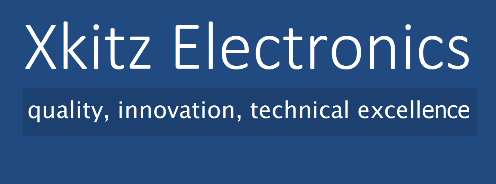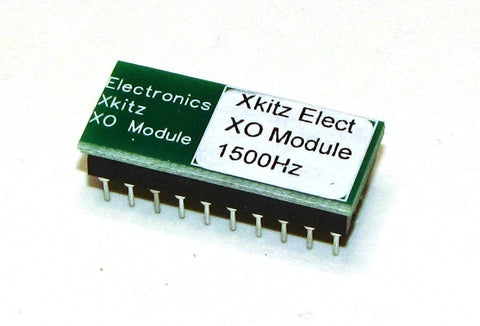Linkwitz-Riley 2-Way Active Crossover, Fully Assembled [XOVER-2]
Notice to our customers: Due to ongoing supply line issues, we currently have a back-log of about 1 week. We will process orders in the order they come in. We apologize for the inconvenience. Thank you, Xkitz
Bi-Amping your speakers is the single most powerful, low cost, and simplest way for audio enthusiasts to reach the realm of true audiophile quality.
The XOVER-2 is a board level product ~ but if you're looking for a fully integrated plug-n-play active crossover, check out the K231 Stereo 3-Way Active Crossover
- 2-way Active Crossover - Splits the highs and lows for separate woofer and tweeter amplifiers
- Audiophile grade Burr-Brown op amps, OPA1654 with 0.00005% THD+N
- Uses high precision filter components for ultra low distortion and pinpoint XO frequency:
- Metal film resistors with 1% and 0.1% precision
- Metalized Polypropylene Film capacitors with 2% precision
- All Analog Design
- High quality Linkwitz-Riley crossover, Constant Voltage, 4th order, 24dB/Octave
- The crossover frequency configuration components are located on a single socketed module – it’s very quick and easy to change the XO frequency by simply plugging in a new module
- We offer a wide range of standard XO frequency modules. Simply select your desired XO frequency from the list below and specify it in the 'Special Instructions' box on the shopping cart page.
- Supports Baffle Step Compensation (BSC). The BSC gain is adjustable and the frequency is configurable to support various baffle sizes
- The high and low outputs are phase aligned to within a fraction of a degree to eliminate distortion at and around the XO frequency
- Separate bass and treble output gain adjustments via precision multi-turn pots
- Double filtered LDO voltage regulator for ultra clean audio
- This is a mono device, two boards are needed for stereo operation
- Made in USA
Specifications:
- THD: 0.0032%
- THD+N: 0.0086%
- Frequency Response Linear from 10Hz – 80KHz
- Input Impedance 20K ohms
- Input Overload: 3.8V peak-to-peak
- Voltage Gain: Adjustable, Max 0dB
- Filter Topology: Linkwitz-Riley, 4th Order, 24dB/octave
- In/Out Jacks: RCA for unbalanced or balanced
- PCB Dimensions: 3.5” x 2” x 0.65” high (89mm x 51mm x 17mm)
- Power supply:
- 10V–24V DC
- 100mA current consumption
- Single positive DC rail - no negative supply required
We support the following Crossover frequencies:
- Any multiple of 10Hz from 30Hz-200Hz (e.g. 60Hz, 70Hz, ... 200Hz)
- 250Hz
- Any multiple of 100Hz from 300Hz-4000Hz
- Any multiple of 500Hz from 4500Hz-12000Hz
Important: When ordering, please specify your desired crossover frequency in the 'Special Instructions' box on the shopping cart page. Or we will ship with default XO frequency of 2000Hz.
Preview the Instruction Manual
The XOVER-2 comes with 1 XO Module. Additional XO Modules are available here
Or use our simple Linkwitz-Riley calculator to select any custom XO frequency
If you want to learn about active crossovers and why you definitely need to dump your passive crossovers ~ please read our post about the advantages of Active Bi-Amping
What is Bi-Amping? It is the replacement of your speaker’s passive crossover, a source of audible distortion of your sound, with a precise Active Crossover placed ahead of your power amps. The power amplifiers drive the woofer and tweeter directly with no passive components getting in the way. The result is nothing short of breathtaking. You’ll hear detail and color in your music you’ve never heard before. The sound stage opens wide in all dimensions, and you can picture every instrument as if it was in the room with you.
One of the most important specs for an active crossover is phase coherence. This is the alignment in time of the high and low outputs. If these are out of phase, sounds that are at or near the crossover frequency will be significantly distorted, because both the woofer and tweeter are both driving at this frequency, and if the channels are out of phase they will each be creating slightly different sound, which creates distortion. This video shows how precisely our channel phases are aligned:
We Also Recommend

![Linkwitz-Riley 2-Way Active Crossover, Fully Assembled [XOVER-2]](http://www.xkitz.com/cdn/shop/products/IMG_9603_large.jpg?v=1577390834)
![Linkwitz-Riley 2-Way Active Crossover, Fully Assembled [XOVER-2]](http://www.xkitz.com/cdn/shop/products/IMG_9603_compact.jpg?v=1577390834)
![Linkwitz-Riley 2-Way Active Crossover, Fully Assembled [XOVER-2]](http://www.xkitz.com/cdn/shop/products/IMG_9607_compact.jpg?v=1577390834)
![Linkwitz-Riley 2-Way Active Crossover, Fully Assembled [XOVER-2]](http://www.xkitz.com/cdn/shop/products/IMG_9595_compact.jpg?v=1577390834)
![Linkwitz-Riley 2-Way Active Crossover, Fully Assembled [XOVER-2]](http://www.xkitz.com/cdn/shop/products/IMG_9601_compact.jpg?v=1577390834)
![Linkwitz-Riley 2-Way Active Crossover, Fully Assembled [XOVER-2]](http://www.xkitz.com/cdn/shop/products/IMG_9590_2ff05efb-c157-4760-a0cd-3003a4418ee4_compact.jpg?v=1577390834)
![Linkwitz-Riley 2-Way Active Crossover, Fully Balanced [XOVER-2B]](http://www.xkitz.com/cdn/shop/products/IMG_9564_large.jpg?v=1577293506)
![Linkwitz-Riley 3-Way Active Crossover, Fully Assembled [XOVER-3]](http://www.xkitz.com/cdn/shop/products/IMG_9608_large.jpg?v=1577725513)
![Linkwitz-Riley 3-Way Active Crossover, Fully Balanced [XOVER-3B]](http://www.xkitz.com/cdn/shop/products/IMG_9537_large.jpg?v=1577295309)
